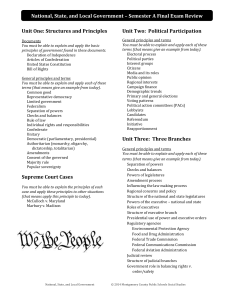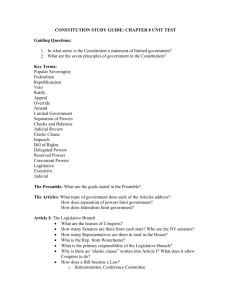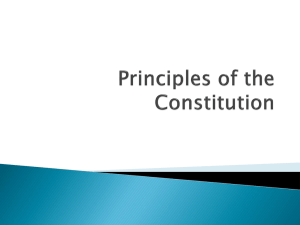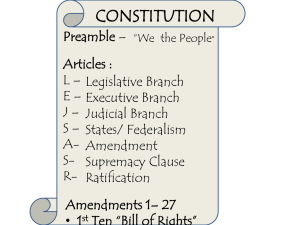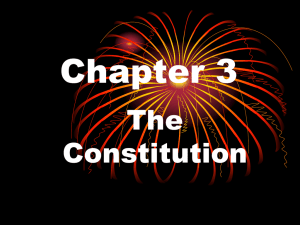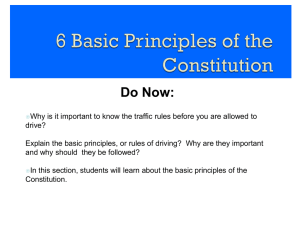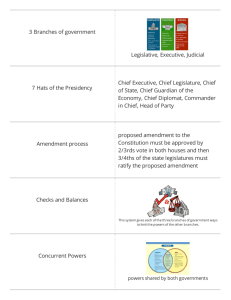Themes - St. Francis School District
advertisement
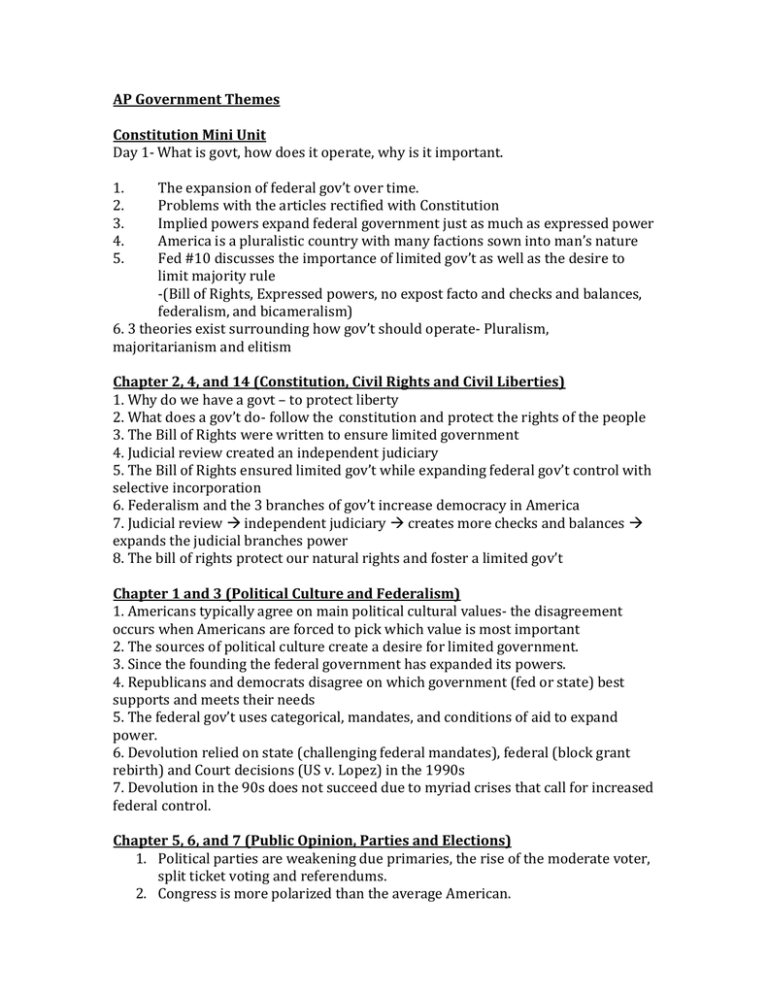
AP Government Themes Constitution Mini Unit Day 1- What is govt, how does it operate, why is it important. 1. 2. 3. 4. 5. The expansion of federal gov’t over time. Problems with the articles rectified with Constitution Implied powers expand federal government just as much as expressed power America is a pluralistic country with many factions sown into man’s nature Fed #10 discusses the importance of limited gov’t as well as the desire to limit majority rule -(Bill of Rights, Expressed powers, no expost facto and checks and balances, federalism, and bicameralism) 6. 3 theories exist surrounding how gov’t should operate- Pluralism, majoritarianism and elitism Chapter 2, 4, and 14 (Constitution, Civil Rights and Civil Liberties) 1. Why do we have a govt – to protect liberty 2. What does a gov’t do- follow the constitution and protect the rights of the people 3. The Bill of Rights were written to ensure limited government 4. Judicial review created an independent judiciary 5. The Bill of Rights ensured limited gov’t while expanding federal gov’t control with selective incorporation 6. Federalism and the 3 branches of gov’t increase democracy in America 7. Judicial review independent judiciary creates more checks and balances expands the judicial branches power 8. The bill of rights protect our natural rights and foster a limited gov’t Chapter 1 and 3 (Political Culture and Federalism) 1. Americans typically agree on main political cultural values- the disagreement occurs when Americans are forced to pick which value is most important 2. The sources of political culture create a desire for limited government. 3. Since the founding the federal government has expanded its powers. 4. Republicans and democrats disagree on which government (fed or state) best supports and meets their needs 5. The federal gov’t uses categorical, mandates, and conditions of aid to expand power. 6. Devolution relied on state (challenging federal mandates), federal (block grant rebirth) and Court decisions (US v. Lopez) in the 1990s 7. Devolution in the 90s does not succeed due to myriad crises that call for increased federal control. Chapter 5, 6, and 7 (Public Opinion, Parties and Elections) 1. Political parties are weakening due primaries, the rise of the moderate voter, split ticket voting and referendums. 2. Congress is more polarized than the average American. 3. There are institutional obstacles to voting. 4. Critical realignments led to critical elections. But due to weakening political parties critical elections no longer foster long lasting one party dominance. 5. There are institutional obstacles that prevent 3rd/minor parties from holding office (ie. Single member district, winner take all plurality system) 6. Voter turnout is higher in Presidential elections than midterm elections. 7. Congressional elections are less competitive than presidential elections. 8. The election cycle has become so long and often times states try to front load to increase relevance. 9. Campaign finance reform has been hard to enact due to free speech 10. Various supreme court cases have affected campaign finance reform. 11. The flood of independent expenditure groups have made effective reform difficult to achieve. Chapter 13 (Judicial Branch) 1. The federal court judges (Supreme Court justices etc) are politically insulated yet also can not stray too far from public opinion. 2. The process of adding cases to its docket requires several considerations. 3. President appts federal judges with advice and consent of Senate. 4. Presidential appts to the court often rely on a series of factors. 5. Judicial interpretation styles are often combative: Judicial activism vs. judicial restraint. Chapter 6 and 11 1. Love hate relationship between media and prez 2. Media given wide latitude of freedom yet privately owned 3. Media helps to set the policy agenda 4. Media has 3 roles that it plays. 5. The power of the presidency rests on public opinion. 6. The President has limited formal powers therefore uses extensively his informal powers. 7. Presidents main task is to enforce the laws reactive role administrative role 8. Growing strife between president and congress for power that explodes in the 1970s. (Budget and Impoundment Act, War Powers Act) 9. Prez uses informal powers to expand control and accomplish political goals Chapter 12, 15 & 16 1. The bureaucracy is the agencies in the executive branch. 2. The bureaucracy’s job is to enforce the law however they have quai- judicial and quasi-legislative powers. 3. A bureaucratic agency’s power will depend on its discretionary authority. 4. Every branch has the power to influence the bureaucracy. 5. It is the 4th branch of policymaking. 6. Iron triangles explain the prevalence of non democratic policies. 7. Issue networks now explain policymaking. Iron triangles only exist in non controversial policies. 8. Entitlement spending comprises most of the federal budget. 9. Fiscal versus Monetary spending 10. OMB symbolizes expansion of federal government. 11. OMB and CBO are responsible for the budget making process. Chapter 9 & 10 1. There are 4 branches of policymaking. Prez, leg, judicial and bureaucracy. 2. The main goal of an interest group is to lobby policymakers to get beneficial policy 3. The rise of hyperpluralism has impacted American government 4. The 3 branches have contributed to the expansion of the executive branch 5. Interest groups use various tactics to lobby the big 3 are grassroots mobilization, campaign $, and litigation 6. Constituent Services Incumbency advantage 7. Interest groups main commodity is information and key to acquisition of power is organization 8. 1. Legislative system that is bicameral. 9. Each chamber has its own characteristics and purposes that affects its main functions. 10. The House is a more local/state body whereas the Senate is a more national/international body. 11. Each chamber has its own characteristics and purposes that affect its main functions. 12. The House is a more local/state body whereas the Senate is a more national/international body. 13. As a result of these differences, Congress can be mired in gridlock, polarization and conflict.

